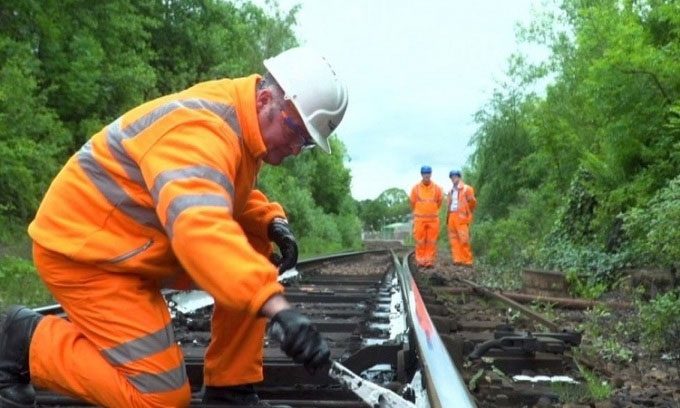To cope with the heat, railway engineers can reduce train speeds, paint tracks white, construct continuous welded rail, or use concrete sleepers.

Maintenance workers painting the tracks white to reflect sunlight and help lower temperatures. (Photo: Network Rail)
Rail services in the UK faced multiple delays and cancellations during the recent heatwave. The entire East Coast Main Line between Edinburgh and London was closed for several hours on July 20 due to excessively high temperatures, according to Interesting Engineering. Like most other construction materials, steel and metals used for railway tracks expand when air temperatures rise. When this expansion is hindered by rail fasteners (which connect the rails to the sleepers), the accumulated stress and compressive forces can cause the tracks to warp. Trains cannot run on warped tracks.
According to Kangkang Tang, a lecturer in Environmental and Civil Engineering at Brunel University, London, when air temperatures reach 30 degrees Celsius, the tracks under direct sunlight can heat up to 50 degrees Celsius. In the UK, authorities will temporarily limit speeds when the tracks reach this temperature, as slower trains exert less pressure on the rails. Some maintenance teams paint the tracks white to cool them down in the summer. According to Network Rail, the organization that manages the railways in the UK, this method can reduce track temperatures by 5 to 10 degrees Celsius. Network Rail staff began painting several railway lines a few days before the heatwave in July.
Continuous welded rail is commonly used worldwide, including in the UK, and is optimized to operate around stress-free temperature (SFT). The higher this temperature, the hotter the rails can become without warping. In the UK, the SFT is set at 27 degrees Celsius, while in the US, the standard temperature range is between 35 to 43 degrees Celsius. However, if the SFT is too high, the rails may not withstand cold temperatures in winter, leading to rail fasteners coming loose. In some countries, tracks can handle high temperature fluctuations by using large concrete sleepers. However, this type of rail costs four times more than traditional gravel-laid tracks.
During the construction of HS2, the new high-speed railway connecting London, Manchester, and Leeds, bridges and overhead wires are equipped with sensors to collect weather data, including air temperature. This data will be used to create a digital simulation of HS2, allowing engineers to predict the impacts of high temperatures and implement preventive measures, thereby reducing the risk of delays and cancellations.


















































